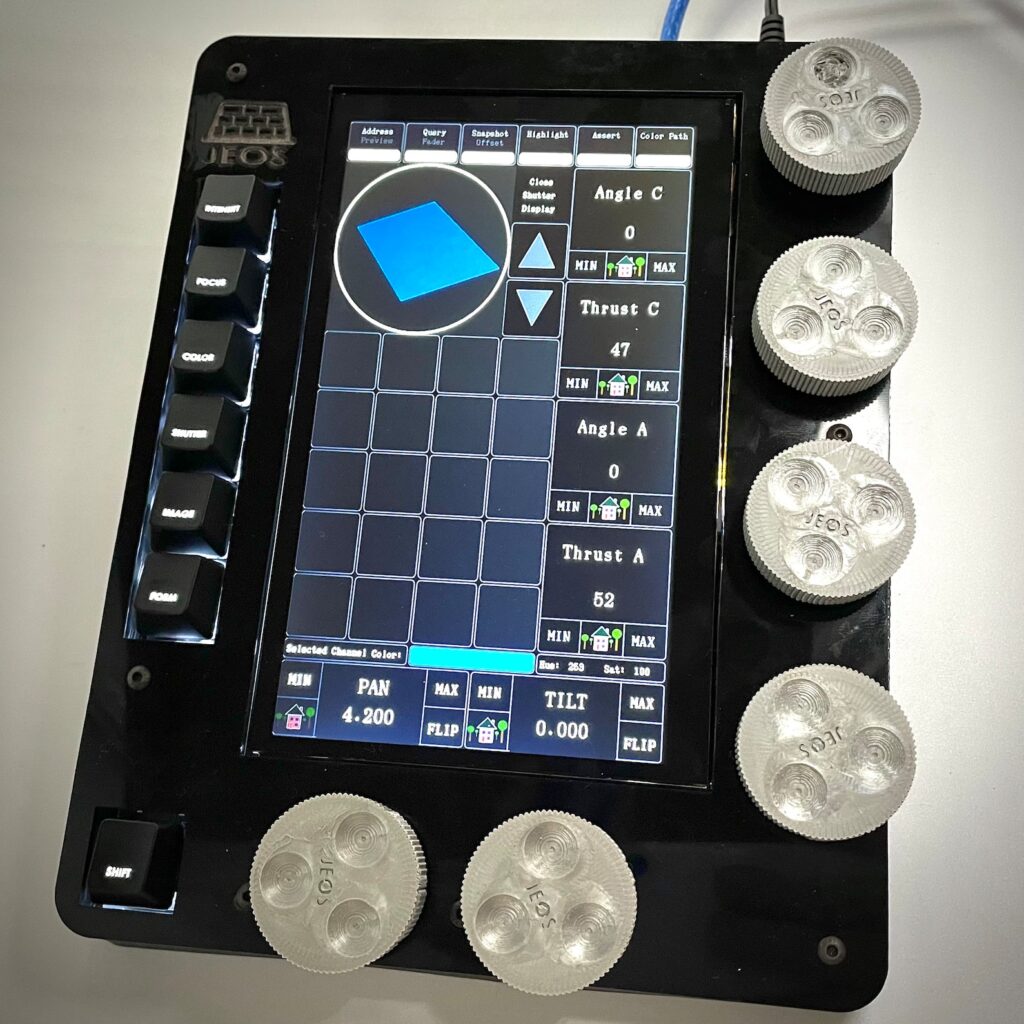I’m not a reviewer, and you should know that. So think of this as your nerd friend telling you about a console device they have tried (and recently purchased for myself). I think this product is a great and affordable solution to a long list of problems that come with running either an Eos Nomad system or an RPU or APU. Recently, I got to use it for two aerial productions I designed and ran, so let me tell you about it.
The JOSC at/2 is a device sold on Etsy that has 6 encoders and a touch screen. It is sold as a kit ($399, soldering skills are required, some parts must be printed) or fully assembled ($649) with a couple options in between. I know my lack of soldering skills, so I ordered a fully assembled kit.

The layout emulates the encoder display of an Eos TI. So the bottom two encoders are always dedicated Pan and Tilt encoders and the four encoders on the right match the encoder display in Eos, automatically populating with whatever functions your selected fixtures have. The central screen is a touch screen, which is great. The encoders feature Min, Max and Home soft keys for your programming convenience. Near the top center, you are able to choose channels, presets, and any palettes to populate on the grid (see above). You have the ability to engage Flexi for any of these views so they function very much like Direct Selects. The screen only fits 20 items, but there are arrow buttons to scroll higher or lower in your list of targets.
At the top of the screen are your soft keys (S1-S6), showing you both what is in the foreground (ready to be selected) and the background (press More SK to toggle). Right below, there is a color picker icon that overlays an approximately 2” x 2” color picker for you to use. It’s a bit small, but it’s a nice feature and similar to the color picker in the encoder display on the console. When you choose Shutters, this automatically populates with the visual icon of the shutters cutting into the beam.

In the Presets and Palette tiles, there is one tile called “Other”. It offers Channels, Groups, Subs, Macros, Pixel Maps, Effects, Magic Sheets, Scenes and Snapshots. Whichever you choose then overwrites the tile that had Channels previously. This makes it easier to switch between your common selections.
Encoders function as both encoders (notice the shift button in the lower left hand corner of the device to give you access to higher resolution control of the encoders) and buttons. I love using encoders to post an attribute to the command line. Most often, I’m using this to command line filter for recording just Zoom to a Beam Palette, for instance. It works great. The feel of the encoders in motion isn’t quite as satisfying as the full console, but it’s easy to get used to rather quickly. I had maybe an awkward 30 minutes when I started programming my show, and then I never noticed the feel again.
There are som minor drawbacks to the product. The encoders extend past the enclosure, which makes it easy to accidentally activate a parameter by brushing the encoder. This can make a mess of your clean cueing. I got much better at not touching them accidentally, but it’s still a bit too easy to not mention. Another drawback is a limit of OSC. Because JOSC is constantly polling the console to ask what parameters the fixture has to populate the encoders, sometime JOSC seems to get confused when you have more than one type of fixture selected, and it won’t show you parameters in those instances. Not a big deal once you know, but something to be aware of.
Build quality is pretty good, but the device will need a protective, structured case to not get damaged in regular transport. I wish they offered a case for it. Speaking of quality, I’ve not used the touch screen outside, so I’m not sure how easy it would be to use in sunlight. I suspect it will be tricky to see.
The device I’m using has firmware 1.1.7. It runs smoothly and I don’t detect lag or anything weird. I used another version that sometimes did lag, and I’m not sure if they have an older version of the firmware or if it’s received more knocks than the one I’m currently using. Good news is the developers are committed to the project and revisions of the software will be emailed to you as they come.
For the price point it occupies and the features it offers, JOSC is a great tool and value. I ordered one myself recently and plan to use it for one of two purposes. I could give it and a Nomad system to my Rigging Programmer when we are doing projects that fit the 12 universe limitation. If the project is a bit bigger, I would let the Rigging Programmer have my IonXE and I would use this and a CMDKey keyboard with my Apex Processing Unit for my main unit programing work. Either way, I think the product is up to the needs of film, theater, corporate, or whatever you may need. If you can’t afford (or fit in your limited space) a Programming Wing, definitely check it out.
3 comments